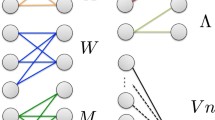Abstract
The large-scale organization of the world economies is exhibiting increasing levels of local heterogeneity and global interdependency. Understanding the relation between local and global features calls for analytical tools able to uncover the global emerging organization of the international trade network. Here we analyze the world network of bilateral trade imbalances and characterize its overall flux organization, unraveling local and global high-flux pathways that define the backbone of the trade system. We develop a general procedure capable to progressively filter out in a consistent and quantitative way the dominant trade channels. This procedure is completely general and can be applied to any weighted network to detect the underlying structure of transport flows. The trade fluxes properties of the world trade web determine a ranking of trade partnerships that highlights global interdependencies, providing information not accessible by simple local analysis. The present work provides new quantitative tools for a dynamical approach to the propagation of economic crises.
Similar content being viewed by others
References
Abeysinghe T and Forbes K (2005). Trade linkages and output-multiplier effects: a structural VAR approach with a focus on Asia. Rev Int Econ 13(2): 356–375
Albert R and Barabási A-L (2002). Statistical mechanics of complex networks. Rev Modern Phys 74(1): 47–97
Almaas E, Kovács B, Vicsek T, Oltvai ZN and Barabási A-L (2004). Global organization of metabolic fluxes in the bacterium Escherichia coli. Nature 427: 839–843
Barrat A, Barthélemy M, Pastor-Satorras R and Vespignani A (2004). The architecture of complex weighted networks. Proc Natl Acad Sci USA 101(11): 3747–3752
Barthélemy M, Gondran B and Guichard E (2003). Spatial structure of the Internet traffic. Physica A 319: 633–642
Baxter M and Kouparitsas M (2003). Trade structure, industrial structure and international business cycles. Am Econ Rev 93(2): 51–56
Bergstrand JH (1985). The gravity equation in international trade: some microeconomic foundations and empirical evidence. Rev Econ Stat 67(3): 474–481
Centeno MA, Cooke A, Curran SR (2006) NetMap combined studies, mapping globalization project. Princeton University, University of Washington, Princeton/Washington
Derrida B and Flyvbjerg H (1987). Statistical properties of randomly broken objects and of multivalley structures in disordered systems. J Phys A 20: 5273–5288
Dorogovtsev SN and Mendes JFF (2003). Evolution of networks: from biological nets to the Internet and WWW. Oxford University Press, Oxford
Forbes K (2002) Are trade linkages important determinants of country vulnerability to crises? In: Sebastian~E, Jeffrey F (eds) Preventing Currency Crises in Emerging Markets. University of Chicago Press, Chicago, pp 77–124
Garlaschelli D and Loffredo MI (2004). Fitness-dependent topological properties of the World Trade Web. Phys Rev Lett 93(18): 188701
Garlaschelli D and Loffredo MI (2005). Structure and evolution of the world trade network. Physica A 355: 138–144
Gleditsch KS (2002). Expanded Trade and GDP Data. J Conflict Resolut 46: 712–724
Glick R and Rose A (1999). Contagion and Trade: Why are Currency Crises Regional. J Int Money Finance 18: 603–627
Goldstein M (1998). The Asian financial crisis: causes, cures and systemic implications. International Institute for Economics, Washington
Helliwell JF, Padmore T (1985) In: Jones RW, Kenen PB (eds) Handbook of international economics, vol 2. Elsevier, North-Holland, Amsterdam
Herfindahl OC (1959). Copper Costs and Prices: 1870–1957. John Hopkins University Press, Baltimore
Hirschman AO (1964). The paternity of an index. Am Econ Rev 54: 761–762
Krempel L and Plümper T (1999). International division of labor and global economic processes: an analysis of the international trade in automobiles. J World Syst Res 5(3): 487–498
Krempel L and Plümper T (2003). Exploring the dynamics of international trade by combining the comparative advantages of multivariate statistics and network visualizations. J Soc Struct 4(1): 1–22
Krugman PR (1995). Growing world trade: causes and consequences. Brookings Pap Econ Act 1995(1): 327–377
Krugman PR and Obstfeld M (2005). International economics: theory and Policy, 7th edn. Addison-Wesley, Lebanon
Noland M, Liu L-G, Robinson S, Wang Z (1998) Global economics effects of the Asian currency devaluations. International Institute for Economics, Washington
Serrano MA (2007) Phase transition in the globalization of trade. J Stat Mech 1:L01002
Serrano MA, Boguñá M (2003) Topology of the world trade web. Phys Rev E 68:015101(R)
Author information
Authors and Affiliations
Corresponding author
Rights and permissions
About this article
Cite this article
Serrano, M.Á., Boguñá, M. & Vespignani, A. Patterns of dominant flows in the world trade web. J Econ Interac Coord 2, 111–124 (2007). https://doi.org/10.1007/s11403-007-0026-y
Published:
Issue Date:
DOI: https://doi.org/10.1007/s11403-007-0026-y




